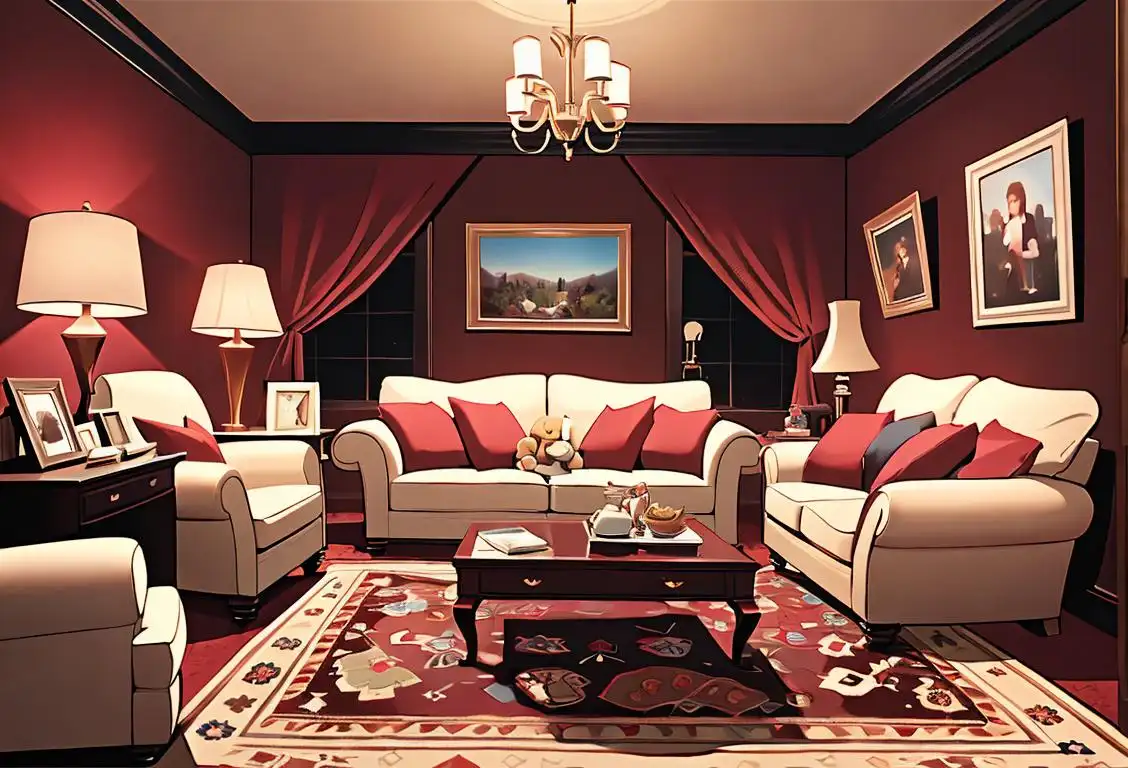National Carpet Day

Welcome to National Carpet Day, a day dedicated to celebrating the soft and cozy floor covering that adds a touch of warmth and style to any space! Whether you have a plush carpet in your living room or a fancy rug in your office, today is the perfect time to appreciate the wonders of carpeting. So, put your feet up, take off your shoes, and let's dive into the fascinating world of carpets!
When is Carpet Day?
It's national carpet day on the 28th May.
The History of National Carpet Day
While the origin of National Carpet Day remains shrouded in mystery (just like finding that missing sock under the carpet), it's clear that carpets have been around for centuries. Ancient civilizations, such as the Persians and Egyptians, were known for their exquisite carpet designs and craftsmanship. These early carpets were not only functional but also represented symbols of wealth and status.
In the digital age, National Carpet Day gained popularity as more and more people started sharing their love for soft flooring on social media. From funny memes featuring carpet patterns to cozy carpet selfies, the internet became the breeding ground for carpet enthusiasts.
Now, every year on May 28th, people from all around the world gather both online and offline to celebrate the comfort and style that carpets bring to their lives.
How to Celebrate National Carpet Day
Celebrating National Carpet Day is as simple as sinking your feet into the soft embrace of your favorite carpet. Here are a few fun ways you can join in the festivities:
- Host a carpet-themed movie night with friends and family. Don't forget to bring your comfiest blankets and pillows to create a cozy carpet fort!
- Share photos of your favorite carpets on social media using the hashtag #NationalCarpetDay. You might discover some amazing carpet designs or connect with fellow carpet enthusiasts.
- Try your hand at DIY carpet cleaning. It's the perfect time to rid your carpet of any mystery stains and give it a fresh new look. Just be careful not to spill your cleaning solution!
Fun Fact about Carpets
Did you know that the world's largest carpet is housed in the Sheikh Zayed Mosque in Abu Dhabi, United Arab Emirates? This magnificent hand-knotted carpet measures a staggering 60,570 square feet and took over two years to complete. It's so big that it can accommodate approximately 40,000 worshipers at once!
History behind the term 'Carpet'
550 BC
Ancient Origins
The history of the term 'carpet' begins in ancient times. The earliest recorded use of carpets dates back to 550 BC in the Achaemenid Empire, present-day Iran. These early carpets were hand-woven textiles made from various natural materials such as wool, silk, and cotton. They were used for a variety of purposes, including floor coverings, wall hangings, and religious rituals. The word 'carpet' itself is derived from the Old French word 'carpite,' meaning thick cloth or canvas.
4th century BCE
Ancient Origins
The history of the term 'carpet' stretches back to the 4th century BCE. The term originated from the Persian word 'karpet,' meaning a cover for a floor. Ancient Persians are believed to be the first to weave carpets, using them both for practical purposes and as displays of wealth and prestige. These early carpets were handwoven using natural materials like wool and silk.
3000 BC
Ancient Beginnings
The history of carpets can be traced back to 3000 BC in ancient Egypt. The earliest known carpet, known as the Pazyryk Carpet, was discovered in a Scythian tomb in Siberia and is believed to have been made in Persia. This carpet, woven with vibrant colors and intricate designs, depicts various motifs and animals.
Neolithic period (7000 - 2000 BCE)
Early woven coverings
The history of carpets can be traced back to the Neolithic period, where early humans wove natural materials like reeds, grass, and rushes to create floor coverings for their dwellings. These early woven coverings provided insulation and protection against cold ground surfaces.
3000 BCE
Early Beginnings
The history of the term 'carpet' begins in ancient times around 3000 BCE in the region of Central Asia. Nomadic tribes in this region began weaving textiles to cover their tents and provide insulation. These early woven pieces were the predecessors of the carpets we know today. They were typically made from animal hides or woven grass.
500 BCE
Ancient Beginnings
Carpets can trace their roots back to ancient civilizations, with evidence of their existence dating as far back as 500 BCE. The earliest known carpets were created by the ancient Persians and were hand-knotted using natural fibers such as wool or silk. These carpets were not only a form of floor covering but also a display of wealth and luxury.
3rd century BCE
Ancient Origins
Carpets can trace their origins back to the 3rd century BCE in ancient Asia. The first-known hand-woven carpets were created by the ancient Persians, who used them mainly for practical purposes such as warmth and protection against the cold. These early carpets were made by knotting various fibers together to form a sturdy and insulating textile.
4500 BCE
The First Carpets
The history of carpets dates back to around 4500 BCE, where evidence of the first carpets was found in the archaeological site of Gonur Tepe in present-day Turkmenistan. These carpets were made of woven grass, reeds, and rushes, and were likely used for insulation and decoration in homes.
2500 BCE
Ancient Beginnings
The term 'carpet' traces its origins back to 2500 BCE when the ancient civilizations of Egypt and Mesopotamia began weaving textiles. These early textiles were used for various purposes, including floor coverings. The word 'carpet' is derived from the Old French word 'carpite,' meaning a thick fabric or covering.
5th century BCE
Ancient Origins
The term 'carpet' has its origins in Persia (modern-day Iran). According to historical evidence, the Persians were the first civilization to weave carpets, dating back to the 5th century BCE. These early carpets were crafted using intricate techniques and featured beautiful designs, often depicting scenes from nature or religious symbols.
4th Century CE
Introduction in Europe
In the 4th century CE, carpets made their way into Europe through trade routes and conquering armies. The Byzantine Empire played a significant role in spreading the use of carpets throughout Europe, particularly in elite circles. These carpets were highly prized and often used as decorative wall hangings or table coverings rather than traditional floor coverings.
500 BCE
Persian Influence
Around 500 BCE, Persian civilization emerged as a dominant force in carpet weaving. Persian carpets, also known as Persian rugs, became highly sought after for their intricate designs and exceptional craftsmanship. With advancements in dyeing techniques and the introduction of more complex looms, Persian carpets attained a level of artistry that set them apart from other woven textiles.
500 BC
Invention of the Loom
Around 500 BC, the invention of the vertical loom revolutionized carpet weaving. This new loom allowed weavers to create larger and more complex carpets with greater ease. With the advent of the loom, carpet production increased, and carpets started to become more widespread.
4th Century BCE
Persian Influence
In the 4th century BCE, Persian culture started to have a profound impact on carpet weaving. The Persians were renowned for their exquisite hand-knotted rugs, known as 'Pazyryk.' These intricate and decorative carpets became highly sought after and were admired for their exceptional craftsmanship.
5th Century BCE
The Persian Influence
By the 5th century BCE, carpets had become an essential part of Persian culture. Persian weavers began producing intricate rugs with decorative patterns and motifs, using various materials such as wool, silk, and cotton. These carpets were highly valued and often used as status symbols or luxury items by the aristocracy.
5th - 4th century BCE
Persian influence and the term 'carpet'
During the 5th - 4th century BCE, Persian influence greatly impacted carpet weaving. The word 'carpet' originated from the Old French word 'carpite,' which was derived from the Latin word 'carpentum' meaning a two-wheeled carriage. This linguistic evolution signifies the association of carpets with luxury and comfort, similar to the lavish interiors of carriages.
5th century CE
Spread through Trade
During the 5th century CE, carpets began to spread beyond Persia as trade networks expanded. The term 'carpet' gained recognition and usage in various regions, including Persian-influenced territories and the Byzantine Empire. Carpets became highly valued commodities, symbolizing luxury and sophistication.
5th century BCE
Influence of Greek civilization
During the 5th century BCE, the ancient Greeks adopted the use of carpets from the Persians. The Greeks were particularly fascinated by the luxurious and decorative qualities of carpets, incorporating them into their homes and palaces as valuable status symbols. Greek weavers began to develop their own carpet-making techniques, combining intricate patterns with vibrant colors.
6th Century AD
Spread to Europe
During the 6th century AD, carpets gained popularity in Europe through trade routes and cultural exchanges with the Middle East. They were highly valued among the wealthy elite and were brought into Europe by traders from the Byzantine Empire. These early carpets were prized for their intricate designs and fine craftsmanship. The word 'carpet' found its way into the English language through the Old Italian word 'carpita,' meaning thick woolen cloth.
7th century CE
Spread in the Islamic World
During the Islamic Golden Age, which began in the 7th century CE, the art of carpet weaving spread throughout the Islamic world. Skilled craftsmen in regions like Turkey, Egypt, and Morocco adopted and refined the Persian techniques, creating their distinct styles and patterns. Carpets from this period often showcased geometric motifs, floral designs, and calligraphy.
8th Century CE
The Islamic Influence
During the 8th century CE, the Islamic empire greatly influenced the development of carpet weaving. Islamic art and architecture incorporated intricate geometric patterns, which translated into the design of carpets. This period saw the rise of mesmerizing Islamic carpet designs, known for their symmetry, floral motifs, and calligraphy.
6th - 4th century BCE
Ancient Greek involvement in carpet weaving
The art of carpet weaving expanded and flourished in Ancient Greece during the 6th - 4th century BCE. Greek weavers introduced intricate patterns and motifs to their carpets, influenced by their mythology and cultural symbols. These carpets were highly valued and considered status symbols, often used in public events and religious ceremonies.
7th Century AD
Islamic Influence
During the 7th century AD, Islamic culture brought significant advancements to carpet weaving. Persian and Islamic carpets became renowned for their intricate designs, luxurious materials, and exquisite craftsmanship. These carpets were sought after by royalty and nobility across the world, further establishing the cultural significance of carpets.
12th century CE
European Influence
The Crusades during the 12th century brought the arrival of Oriental carpets to Europe. These exquisite textiles captured the fascination of European nobility and became status symbols. Wealthy families began displaying carpets in their castles and palaces, introducing them to the European upper class. This exposure sparked an interest in carpet production within Europe itself.
711 CE
Islamic Expansion
During the Islamic expansion in the 8th century CE, the art of carpet weaving spread across the Middle East and North Africa. The term 'carpet' itself has its origins in the Arabic word 'qali', which means a covering or something spread out. This linguistic influence of Arabic on the term 'carpet' reflects the cultural impact and integration of different societies.
13th Century CE
European Introduction
Carpet weaving was introduced to Europe in the 13th century CE through trade with the Middle East and the Crusades. The high-quality Persian carpets captured the imagination of European nobility and quickly gained popularity as luxurious floor coverings. The term 'carpet' became more commonly used during this period.
13th century
The Rise of Carpet Industry in Europe
In the 13th century, the Crusaders brought back Persian carpets to Europe, sparking a growing interest in these exotic textiles. The wealthy elite began to acquire and commission carpets, which were considered prized possessions and symbols of prestige and wealth. Consequently, the demand for carpets increased, leading to the establishment of carpet-weaving workshops across Europe.
13th century CE
European Connections
In the 13th century CE, as trade routes expanded further, carpets began to make their way into Europe. The term 'carpet' entered the European lexicon, mainly through interactions with the Islamic world. Carpets gained popularity among European nobility as exotic imports, and European royalty often commissioned carpets that combined traditional Persian designs with European influences.
11th Century CE
Rise of Carpet Weaving Centers
During the 11th century CE, carpet weaving centers began to emerge in various regions, leading to the development of distinct carpet styles and techniques. One notable center was the city of Kashan in Persia, which gained prominence for its intricately designed carpets woven with floral motifs and geometric patterns. These carpets became highly coveted luxury items.
13th Century
Royal Affection
In the 13th century, carpets became a symbol of wealth and luxury. Kings and nobles in Europe adorned their palaces and castles with magnificent carpets imported from the East. These carpets were often prized possessions and seen as symbols of power and status. The popularity of carpets grew rapidly, leading to the establishment of carpet weaving centers in various European cities.
13th Century CE
European Introduction
By the 13th century CE, carpets started making their way into Europe through trade routes. European nobility soon developed a taste for these luxurious floor coverings, and carpets became popular among the upper class. This led to the establishment of royal carpet workshops, which employed skilled weavers to create bespoke pieces for palaces and castles.
16th Century
Renaissance Influence
During the Renaissance period, carpets became even more prominent in European culture. Influenced by the intricate designs and rich colors of Oriental carpets, European carpet makers began to mimic these styles. The demand for carpets grew, and local carpet weaving industries flourished. The word 'carpet' became firmly entrenched in the English language, referring to both woven floor coverings and larger textile artworks.
12th Century AD
Development of Knotted Carpets
In the 12th century AD, the art of carpet weaving expanded further with the introduction of knotted carpets. This technique, which originated in Central Asia, allowed weavers to create more intricate and durable carpets. The knotting method spread rapidly throughout the Middle East, Asia, and eventually Europe, contributing to the rich tapestry of carpet history.
7th - 8th century CE
Islamic civilization and intricate carpet designs
Islamic civilization played a crucial role in the development of carpet weaving during the 7th - 8th century CE. Islamic carpets, known for their stunning beauty and intricate designs, became renowned throughout the world. Islam's prohibition of human and animal figures in art led to the prominence of geometric and floral patterns, reflecting the religious and cultural beliefs of their time.
16th century CE
The Rise of Carpet Manufacturing
By the 16th century CE, carpet manufacturing had evolved into a prominent industry. Skilled weavers established workshops in various regions, particularly in Persia, Turkey, and India. These workshops produced intricately designed and finely woven carpets that were sought after by collectors and connoisseurs. The term 'carpet' became synonymous with these exquisite textiles.
16th century
The Age of Oriental Carpets
During the 16th century, the term 'carpet' became associated with the luxurious and intricately woven rugs produced in the Oriental regions, including Persia, Turkey, and India. Oriental carpets featured elaborate motifs, stunning colors, and exceptional craftsmanship. These carpets gained popularity in Europe, with wealthy nobles and aristocrats competing to possess the most exquisite examples.
13th Century
European Encounter
Carpet weaving reached Europe during the 13th century through trade channels with the Middle East. The Crusades and the thriving silk trade contributed to the popularity of carpets in Europe. Influenced by the Persian and Islamic designs, European weavers began producing their own versions of carpets, incorporating local motifs and styles.
14th Century CE
Carpet Renaissance
The 14th century CE marked the beginning of the carpet renaissance in Europe. Carpets became more accessible to the middle class as production methods improved and trade routes expanded. Persian carpets, in particular, gained popularity due to their exquisite craftsmanship and artistic designs. Many European paintings from this period depict carpets as status symbols and objects of beauty.
16th century CE
Renaissance Rugs
During the Renaissance period in Europe, carpet weaving experienced a significant revival. The wealthy merchant classes, as well as ruling families, commissioned intricate carpets as luxury items for their homes. Renaissance carpets were often large and featured complex designs with mythological and historical motifs.
16th Century CE
Oriental Carpets
The 16th century CE marked the peak of Oriental carpet production. Persian and Turkish carpets, with their intricate designs and vibrant colors, became prized possessions around the world. European royalty amassed impressive carpet collections, and the term 'oriental carpet' was coined to describe these beautiful creations.
19th century
Industrialized Carpet Production
The 19th century marked a significant shift in carpet production. With the advent of industrialization, carpet weaving transitioned from a predominantly handcrafted process to a mechanized one. This led to increased production rates and accessibility of carpets to a wider range of social classes. Factories in Europe and America began to mass-produce carpets, making them more affordable and readily available.
16th Century CE
The Renaissance Influence
During the Renaissance period, carpets underwent further transformations in design and style. Influenced by the artistic and cultural movements of the time, carpets began incorporating motifs inspired by classical mythology, biblical scenes, and exotic flora and fauna. They became more than just floor coverings – they became works of art.
19th Century
Industrial Revolution and Mass Production
The 19th century marked a significant turning point in the production of carpets. With the advent of industrialization, the carpet industry underwent a transformation. Steam-powered looms and advanced manufacturing techniques revolutionized carpet making, allowing for mass production and more affordable prices. Carpets became accessible to a wider range of social classes, moving beyond the realm of the elite.
16th Century AD
European Influence
During the 16th century AD, European explorers and traders brought exotic carpets from the East to Europe. These carpets, admired for their beauty and craftsmanship, quickly gained popularity among the European aristocracy. The demand for carpets in Europe led to the establishment of production centers and the emergence of renowned carpet weaving regions.
16th Century
Mughal Magnificence
In the 16th century, the Mughal Empire flourished in India, bringing with it a golden age of carpet weaving. Mughal carpets, featuring intricate floral patterns and motifs, were highly regarded for their elegance and grandeur. This period marked a significant development in carpet design, showcasing the fusion of Persian and Indian artistic traditions.
19th century CE
Industrialization and Global Trade
The 19th-century industrial revolution brought mechanization to carpet production. Machines facilitated faster weaving processes, making carpets more affordable and accessible to a wider population. Additionally, global trade routes expanded, allowing carpets from various regions to reach new markets worldwide. This era also saw the rise of carpet manufacturers in countries like England and the United States.
19th century CE
Industrialization and Mass Production
The 19th century CE marked a significant shift in the carpet industry with the advent of industrialization. Steam-powered looms were introduced, allowing for mass production of carpets. The term 'carpet' now encompassed not only handmade carpets but also machine-woven varieties. This new era of manufacturing made carpets more accessible to a broader range of social classes.
16th Century CE
Carpet Manufacturing in Europe
In the 16th century CE, carpet manufacturing started to take root in Europe. Initially, European carpets imitated the designs and techniques of Persian carpets. However, over time, European carpet weavers began developing their own unique styles and patterns. The inclusion of cultural influences from various countries, such as France and England, led to the creation of distinct European carpet designs.
19th Century CE
Industrial Revolution
The Industrial Revolution in the 19th century brought significant changes to carpet production. The invention of powered machinery revolutionized the weaving industry, making carpets more affordable and accessible. The term 'carpet' expanded to include machine-made variants, in addition to the traditional hand-woven rugs.
12th - 16th century CE
Medieval European carpet production
During the medieval period of European history (12th - 16th century CE), carpet production spread across the continent. Initially, carpets were mostly imported from the East, but as demand grew, European centers like Spain, France, and England began producing their own carpets. These carpets were luxurious, featuring elaborate designs and vibrant colors.
20th century
Innovation and Design Diversity
The 20th century brought about various advancements and innovations in carpet manufacturing. Synthetic fibers such as nylon and polyester were introduced, offering new possibilities for design, durability, and affordability. Additionally, modern technology allowed for the creation of carpets with intricate patterns, vibrant colors, and improved stain-resistance. This era witnessed a proliferation of carpet styles catering to diverse aesthetic preferences.
19th Century CE
Industrialization and Global Trade
As industrialization took hold in the 19th century, carpet production shifted from hand-weaving to mechanized processes. This led to increased accessibility to carpets for the middle class. Moreover, international trade allowed for the exchange of carpet-making techniques, leading to the blending of various regional styles and the emergence of new designs.
21st Century
Modern Innovations
In the 21st century, carpets have evolved into a dynamic and versatile flooring option. Modern technologies have introduced stain-resistant materials, eco-friendly fibers, and innovative designs. Carpets now come in an array of styles, patterns, and textures, catering to various aesthetic preferences and functional needs. Today, carpets continue to be a popular choice for interior decoration, offering comfort, insulation, and acoustic benefits.
20th century CE
Carpet in Modern Culture
In the 20th century CE, carpets became an integral part of modern interior design. The term 'carpet' expanded to include various types and styles, including wall-to-wall carpets, area rugs, and carpet tiles. With advancements in technology and manufacturing techniques, carpets became available in a wide range of materials, colors, and patterns, catering to diverse aesthetic preferences.
Present
Contemporary Carpets
Today, the art of carpet weaving continues to thrive globally. Different countries have their unique carpet traditions, such as the Persian rugs, Turkish kilims, Moroccan Berber carpets, and Indian rugs. Carpets have become an integral part of interior design, adding warmth, beauty, and cultural significance to homes and public spaces around the world.
19th Century CE
Industrial Revolution and Carpet Production
The industrial revolution in the 19th century CE brought significant advancements in carpet production. With the invention of new weaving techniques and machinery, such as the Jacquard loom, carpets could be manufactured at a faster rate and with greater precision. This resulted in increased availability and affordability of carpets, making them more prevalent in households across various social classes.
19th century CE
Industrial revolution and machine-made carpets
The industrial revolution in the 19th century revolutionized carpet production. Power looms and machines replaced traditional hand-weaving techniques, allowing carpets to be produced faster and more affordably. This mass production made carpets more accessible to a wider range of people, bringing comfort and style to countless households.
20th Century CE
Modern Innovation
In the 20th century, carpet manufacturing underwent further advancements. Synthetic materials like nylon and polyester were introduced, offering durability and stain resistance. Carpets became a popular flooring choice for homes, offices, and public spaces, contributing to the rise of the modern carpet industry.
19th Century
Industrial Revolution
The rise of the Industrial Revolution in the 19th century brought mechanization to carpet production. Power looms and the availability of synthetic dyes revolutionized the industry, making carpets more affordable and accessible. This period of industrialization led to the mass production of carpets, marking a shift from traditional handwoven methods.
19th Century AD
Industrial Revolution and Mass Production
The 19th century saw the industrial revolution transforming the carpet industry. Mechanical looms were introduced, allowing for mass production of carpets. Synthetic dyes were also invented, expanding the color palettes available to carpet weavers. As a result, carpets became more affordable and accessible to a wider range of people.
Present day
Modern carpet innovations
In the present day, carpet manufacturing has undergone various innovations. Synthetic fibers such as nylon and polyester are commonly used, providing increased durability and stain resistance. Carpets now come in a wide array of designs and styles, catering to diverse tastes and interior aesthetics. With advancements in technology and sustainable practices, carpets continue to be an integral part of interior design and comfort.
20th Century CE
Modern Carpet Industry
The 20th century CE witnessed further advancements in the carpet industry, including the introduction of synthetic fibers like nylon and polyester. These new materials offered enhanced durability, stain resistance, and affordability. Carpet design also experienced a shift, with more contemporary and abstract patterns gaining popularity alongside traditional motifs. Today, carpets continue to be an integral part of interior design, providing both comfort and aesthetic appeal.
21st Century
Global Appreciation
Today, carpets are widely appreciated as decorative elements in homes, offices, and public spaces worldwide. The term 'carpet' has evolved to encompass various styles, materials, and techniques. From traditional Oriental rugs to modern cut-pile carpets, it is a testament to the enduring legacy and cultural significance of carpet weaving.
20th Century AD
Modern Innovations
In the 20th century, technological advancements led to further innovations in carpet manufacturing. Power looms and tufting machines revolutionized the process, making carpets even more accessible and affordable. Different carpet styles and materials emerged, catering to various tastes and interior design preferences.
Present Day
Carpet's Ubiquity
Today, carpets have become a ubiquitous feature of interior design across the globe. They provide comfort, insulation, and aesthetic appeal to a wide range of spaces. The term 'carpet' encompasses various styles, materials, and techniques, reflecting the diversity and evolution of this essential element in our lives.
21st Century CE
Contemporary Carpet Industry
In the 21st century, the carpet industry has seen remarkable advancements in technology, materials, and design. Modern carpets cater to a wide range of tastes and preferences, with options ranging from traditional hand-knotted rugs to sleek, minimalist designs. Carpets continue to be an integral part of interior design, adding warmth, beauty, and personality to homes and spaces worldwide.
Did you know?
The world's largest carpet is housed in the Sheikh Zayed Mosque in Abu Dhabi, United Arab Emirates. It measures a staggering 60,570 square feet!Tagged
fun propertyFirst identified
28th May 2017Most mentioned on
28th May 2017Total mentions
22Other days
Action Day
Suicide Prevention Month Day
Seniors Day
Veterans Day
Happiness Day
Golf Course As Trump Departed After His Second Consecutive Day
Opposite Day
Tv On The Same Day
Honesty Day
Insurance Awareness Day









